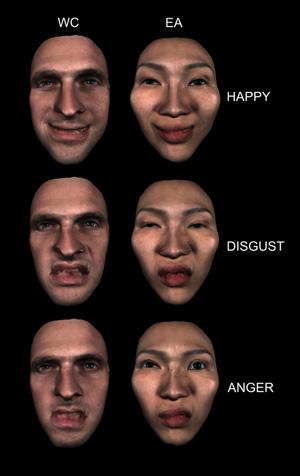Darwin was wrong: Facial expressions of emotion are not universal
University of Glasgow
Source - http://phys.org/wire-news/96115961/darwin-was-wrong-facial-expressions-of-emotion-are-not-universal.html

Photo: University of Glasgow
The belief that all humans communicate six basic emotions through their facial expressions has been refuted by researchers at the University of Glasgow.
It was Charles Darwin who first noted in his 1872 book The Expression of the Emotions in Man and Animals that people from different cultures express the same state of mind by the same facial movements, but the Glasgow researchers say this is not the case.
Using a unique, sophisticated computer graphics platform developed at the University of Glasgow, researchers in the Institute of Neuroscience and Psychology, and the School of Psychology were able to create the first-ever modelling of four-dimensional mental representations of six basic facial expressions in two cultures.
Fifteen Western Caucasian and 15 East Asian subjects were selected to view 4,800 animated 3D images of faces exhibiting randomly generated facial movements.
Subjects interpreted the random facial animations as expressive if the random facial movements corresponded to their mental representation of a specific facial expression. Thus, using their subjective perceptions, subjects categorised each facial animation according to the six basic emotions and rated the intensity of the emotion perceived. This allowed the researchers to identify the specific facial movements each culture uses to represent each of the six basic facial expressions of emotion.
The results showed that while Westerners represent each of the six basic emotions with a distinct set of facial movements common to the group, Easterners do not. Furthermore, East Asians represent emotional intensity with distinctive early eye activity whereas Westerners use other face features.
Lead researcher Rachael Jack, said: “Our results show that facial expressions of emotion are culture specific, refuting the notion that human emotion is universally represented by the same set of six distinct facial expressions.
“For Western Caucasian, there does indeed appear to be six basic facial expressions of emotion, but the same is not true for East Asians.
“So while expressions of fear and disgust originally served as an adaptive function in early humans, facial expression signals have since evolved and diversified to serve the primary role of emotion communication during social interaction.
“Our data highlights the powerful influence of culture on shaping basic behaviours once considered biologically hardwired.”
The system used by scientists studying facial expressions – the Facial Action Coding System (FACS) – identifies specific muscles used in generating facial expressions. The activation of different muscles combine to make a facial expression.
The Glasgow team – Rachael Jack, Oliver Garrod, Hui Yu and Philippe Schyns – used a unique computer platform developed at the University whereby they scanned and recorded people who are able to move all of the 40-plus muscles coded within FACS individually.
This allowed them to generate any expression on the computer and control the intensity and speed.
In the study the random expression were reverse correlated – meaning the subjects themselves gave meaning to the expression based on their own assumptions.
A result of the study is that the researchers were able to compile a database of valid East Asian facial expressions, since up until now, the gold standard in emotion research comprised facial expressions only recognised by Western Caucasian culture due to the belief that facial expressions of emotions are universal.
The research was funded by the Economic and Social Research Council, the Medical Research Council and the British Academy.
More information: Facial expressions of emotion are not culturally universal, PNAS, Published online before print April 16, 2012, doi: 10.1073/pnas.1200155109
Abstract
Since Darwin’s seminal works, the universality of facial expressions of emotion has remained one of the longest standing debates in the biological and social sciences. Briefly stated, the universality hypothesis claims that all humans communicate six basic internal emotional states (happy, surprise, fear, disgust, anger, and sad) using the same facial movements by virtue of their biological and evolutionary origins [Susskind JM, et al. (2008) Nat Neurosci 11:843–850]. Here, we refute this assumed universality. Using a unique computer graphics platform that combines generative grammars [Chomsky N (1965) MIT Press, Cambridge, MA] with visual perception, we accessed the mind’s eye of 30 Western and Eastern culture individuals and reconstructed their mental representations of the six basic facial expressions of emotion. Cross-cultural comparisons of the mental representations challenge universality on two separate counts. First, whereas Westerners represent each of the six basic emotions with a distinct set of facial movements common to the group, Easterners do not. Second, Easterners represent emotional intensity with distinctive dynamic eye activity. By refuting the long-standing universality hypothesis, our data highlight the powerful influence of culture on shaping basic behaviors once considered biologically hardwired. Consequently, our data open a unique nature–nurture debate across broad fields from evolutionary psychology and social neuroscience to social networking via digital avatars.